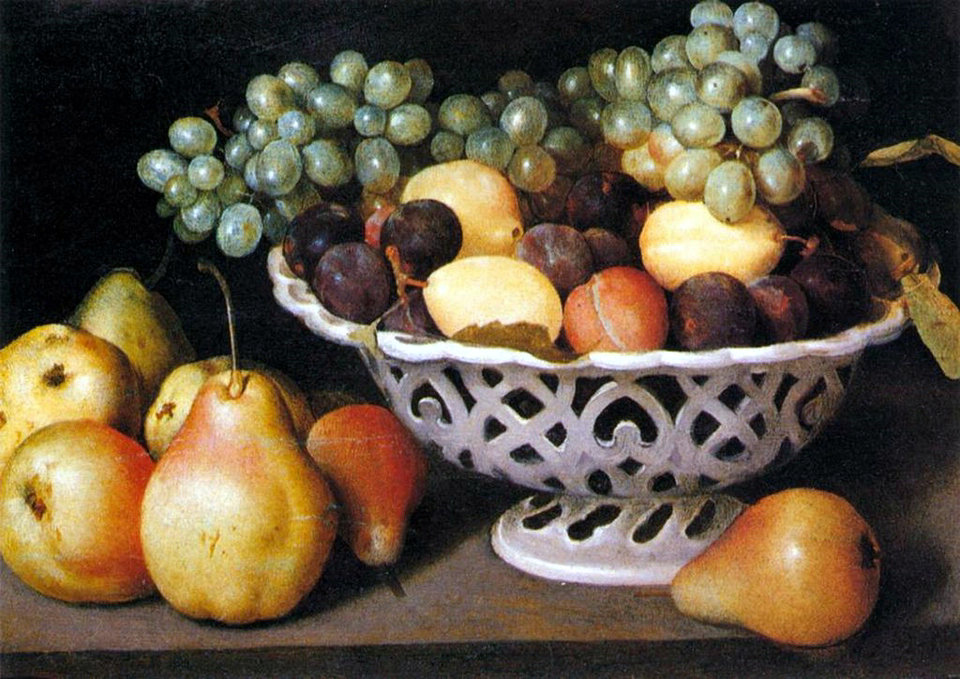

In Spanish art, a bodegón is a still-life painting depicting pantry items, such as victuals, game, and drink, often arranged on a simple stone slab, and also a painting with one or more figures, but significant still-life elements, typically set in a kitchen or tavern. Starting in the Baroque period, such paintings became popular in Spain in the second quarter of the 17th century. The tradition of still-life painting appears to have started and was far more popular in the contemporary Low Countries, today Belgium and Netherlands (then Flemish and Dutch artists), than it ever was in southern Europe. Northern still lifes had many subgenres; the breakfast piece was augmented by the trompe-l’œil, the flower bouquet, and the vanitas.
In Spain there were much fewer patrons for this sort of thing, but a type of breakfast piece did become popular, featuring a few objects of food and tableware laid on a table. Still-life painting in Spain, also called bodegones, was austere. It differed from Dutch still life, which often contained rich banquets surrounded by ornate and luxurious items of fabric or glass. The game in Spanish paintings is often plain dead animals still waiting to be skinned. The fruits and vegetables are uncooked. The backgrounds are bleak or plain wood geometric blocks, often creating a surrealist air. Even while both Dutch and Spanish still life often had an embedded moral purpose, the austerity, which some find akin to the bleakness of some of the Spanish plateaus, appears to reject the sensual pleasures, plenitude, and luxury of Dutch still-life paintings.
Even though Italian still-life painting was gaining in popularity, it remained historically less respected than the “grand manner” painting of historical, religious, and mythic subjects. On the other hand, successful Italian still-life artists found ample patronage in their day. Furthermore, women painters, few as they were, commonly chose or were restricted to painting still life; Giovanna Garzoni, Laura Bernasconi, Maria Theresa van Thielen, and Fede Galizia are notable examples.
Many leading Italian artists in other genre, also produced some still-life paintings. In particular, Caravaggio applied his influential form of naturalism to still life. His Basket of Fruit (c. 1595–1600) is one of the first examples of pure still life, precisely rendered and set at eye level. Though not overtly symbolic, this painting was owned by Cardinal Federico Borromeo and may have been appreciated for both religious and aesthetic reasons. Jan Bruegel painted his Large Milan Bouquet (1606) for the cardinal, as well, claiming that he painted it ‘fatta tutti del natturel’ (made all from nature) and he charged extra for the extra effort. These were among many still-life paintings in the cardinal’s collection, in addition to his large collection of curios. Among other Italian still life, Bernardo Strozzi’s The Cook is a “kitchen scene” in the Dutch manner, which is both a detailed portrait of a cook and the game birds she is preparing. In a similar manner, one of Rembrandt’s rare still-life paintings, Little Girl with Dead Peacocks combines a similar sympathetic female portrait with images of game birds.
In Catholic Italy and Spain, the pure vanitas painting was rare, and there were far fewer still-life specialists. In Southern Europe there is more employment of the soft naturalism of Caravaggio and less emphasis on hyper-realism in comparison with Northern European styles. In France, painters of still lifes (nature morte) were influenced by both the Northern and Southern schools, borrowing from the vanitas paintings of the Netherlands and the spare arrangements of Spain.
Italian gallery
| Fede Galizia (1578–1630), Apples in a Dish (c. 1593) |
Fede Galizia, (1578–1630), Maiolica Basket of Fruit (c. 1610), private collection |
Giovanna Garzoni (1600–1670), Still Life with Bowl of Citrons (1640), tempera on vellum, Getty Museum, Pacific Palisades, Los Angeles, California |
Giacomo Francesco Cipper (1664–1736), Still Life of Fish and Shellfish |
|---|
Source From Wikipedia